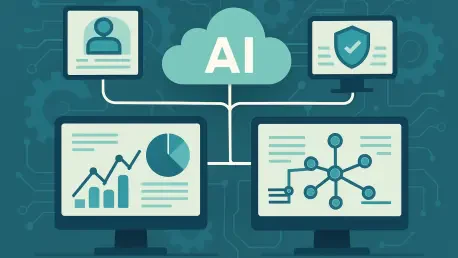In an era where enterprise networks grapple with unprecedented complexity due to cloud adoption and remote workforces, a staggering 70% of IT leaders report challenges in managing sprawling digital ecosystems, underscoring a critical pain point in today’s business landscape. Traditional networking solutions often fall short against the demands of modern traffic patterns. Enter Alkira, a Network-as-a-Service (NaaS) pioneer, whose recent unveiling of AI-driven tools promises to transform how enterprises tackle these hurdles. This market analysis delves into the implications of Alkira’s innovations, particularly the Model Context Protocol (MCP) Server and the Alkira Network Infrastructure Assistant (NIA) copilot, examining their impact on industry trends, operational efficiency, and future growth trajectories. By exploring these advancements, the goal is to illuminate how AI is redefining networking and what this means for businesses navigating digital transformation in 2025.
Unpacking Market Trends and Alkira’s Strategic Positioning
Rising Demand for AI in Enterprise Networking
The enterprise networking market is undergoing a seismic shift, driven by the integration of artificial intelligence to manage increasingly intricate systems. Industry data reveals a surge in demand for solutions that can automate complex tasks, with AI adoption in networking projected to grow at a compound annual rate of 25% from 2025 to 2027. This trend stems from the need to address challenges like multi-cloud environments and heightened cybersecurity risks, which traditional hardware-centric models struggle to handle. Alkira has capitalized on this momentum, positioning itself as a leader by embedding AI into its NaaS offerings. The company’s reported 60% revenue growth in recent times highlights a robust market appetite for scalable, intelligent networking solutions, especially among large-scale enterprises, including a notable Fortune 10 client.
Competitive Landscape and Innovation Drivers
Amid fierce competition, Alkira distinguishes itself by focusing on both automation and user experience, setting a benchmark for rivals in the NaaS space. Competitors are racing to integrate similar AI functionalities, but Alkira’s dual approach—system-level orchestration via the MCP Server and human-centric support through the NIA copilot—offers a unique value proposition. Market analysts note that the push toward agentic AI systems, which autonomously manage and optimize networks, is becoming a key differentiator. This aligns with broader industry drivers such as the need for real-time adaptability and zero-trust security frameworks, areas where Alkira has already made strides with prior enhancements like zero-trust network access (ZTNA). The competitive pressure to innovate continuously shapes a landscape where agility and foresight are paramount.
Economic and Regulatory Influences on Adoption
Economic factors and regulatory environments play significant roles in shaping the adoption of AI-driven networking tools. The scalability of NaaS, paired with AI, offers cost efficiencies for enterprises by reducing reliance on expensive hardware and manual labor, a boon in tight economic climates. However, regional disparities in data privacy laws pose challenges for tools like the MCP Server, which facilitate cross-platform integrations. Compliance with stringent regulations in sectors like finance and healthcare requires localized adaptations, potentially slowing deployment timelines. Despite these hurdles, the economic incentive to streamline operations continues to drive investment in AI networking solutions, with market projections suggesting widespread adoption across mid-sized and large enterprises by the end of this decade.
Deep Dive into Alkira’s AI Innovations
MCP Server: A Catalyst for System Automation
At the core of Alkira’s offerings lies the MCP Server, a tool engineered to bridge agentic AI systems with network infrastructure through structured, human-readable data outputs. This innovation enables seamless multi-system orchestration, allowing AI agents to interact with platforms like ticketing and monitoring tools while maintaining strict security via role-based access controls. Early feedback from adopters indicates a marked decrease in manual oversight, though concerns linger about compatibility with diverse backend systems. The MCP Server’s ability to present data in accessible formats, such as tabular summaries, positions it as a linchpin for automation, potentially reshaping how enterprises manage network deployments at scale.
NIA Copilot: Redefining User Interaction
Complementing system-level advancements, the NIA copilot targets network administrators with a conversational interface designed to simplify complex operations. This tool excels in guiding users through troubleshooting tasks, such as diagnosing connectivity issues by tracing paths and suggesting actionable fixes, all while providing transparent explanations of its processes. Unlike traditional interfaces that often require steep learning curves, NIA lowers barriers for operators, enhancing productivity. However, the accuracy of its recommendations in rare, edge-case scenarios remains a point of scrutiny, underscoring the need for human verification. Its focus on natural language interaction sets a new standard for user-centric design in networking technology.
Future Projections: AI as a Networking Cornerstone
Looking ahead, the trajectory of AI in networking points to deeper integration in predictive analytics and autonomous decision-making. Market forecasts suggest that by 2027, AI tools could preemptively address network bottlenecks, minimizing downtime and optimizing performance without human intervention. Alkira’s current innovations lay the groundwork for such capabilities, with potential enhancements in machine learning likely to make tools like NIA even more intuitive. Additionally, the economic benefits of reduced operational costs could accelerate adoption, though regulatory shifts around data sovereignty may introduce complexities. Speculation abounds that AI might eventually handle vendor negotiations autonomously, fundamentally altering market dynamics and client relationships in the networking sector.
Reflecting on Market Implications and Strategic Pathways
Looking back, this analysis of Alkira’s AI-driven tools reveals their profound influence on the enterprise networking market, spotlighting the MCP Server and NIA copilot as pivotal innovations that address both systemic automation and human usability needs. Their introduction marks a turning point, aligning with industry trends toward agentic AI and reinforcing the importance of scalability and security in modern infrastructure. The significant revenue growth and high-profile client engagements Alkira achieved underscore the market’s readiness for such solutions. For enterprises, the path forward involves strategic adoption—starting with pilot implementations to bridge infrastructure gaps, while IT leaders need to prioritize transparency in AI processes to maintain trust and control. As the landscape continues to evolve, businesses must focus on incremental integration, ensuring compliance and workforce readiness, to leverage these advancements for sustained efficiency and resilience in a competitive digital arena.









